It may come as a surprise to some of you that there are in fact different formations in Volleyball.
Now it’s true there isn’t anywhere near as many formations as things such as Soccer or Football.
In fact there are actually only really 3 formations that you need to know in Volleyball.
The 3 Volleyball formations are the 4-2, the 5-1 and lastly the 6-2. These numbers actually relate to the number of hitters and the number of setters on court at any one time.
For example the 4-2 means there are 4 hitters and 2 setters.

No this doesn’t mean that in the 6-2 formation there are 8 players on court, however it does mean that every player on the court is considered a hitter.
I will dive into much more detail later on how this works.
These different formations are normally used depending on the level of players as opposed to a sport like Soccer where it is used more to gain a tactical advantage or overwhelm a particular area on the field.
Let’s take a deep dive into each rotation and I will show exactly how to rotate round the court in each of them.
Table of Contents
The 4-2 Volleyball Formation
The 4-2 volleyball Formation is very commonly used in lower levels or beginner volleyball.
The main reason for this is because it reduces the amount of rotations required at any given time and allows players to focus on defending and attacking only.
As the name suggests this formation means you have 4 hitters and 2 setters, as with all rotations the two setters will line up opposite each other on the court, so if the setter starts at the front right position, the other setter will be in the back left position.
The setter who is in the front row will always be the setter, whilst the setter in the back row will focus solely on defense.
This formation is also used a lot if the team isn’t very diverse in terms of good hitters.
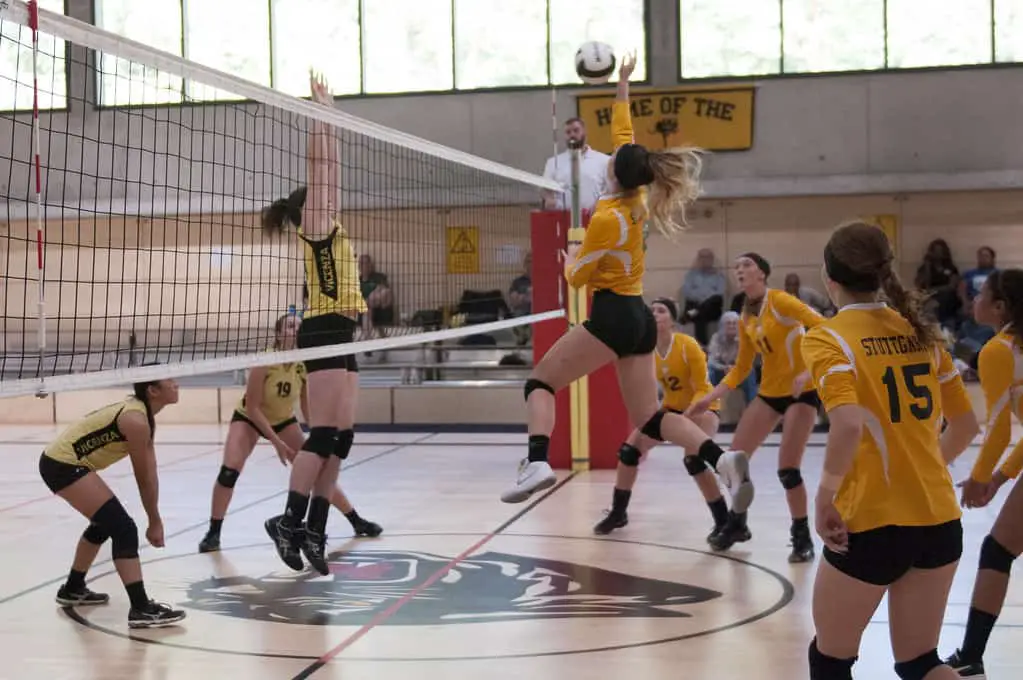
Advantages of the 4-2 Formation
Easy to Learn & Follow
The 4-2 rotation isn’t seen very often in competitive volleyball but it is a great formation to introduce new players into the sport and teach them about positions and rotations without some of the more complicated rotations that the 6-2 and 5-1 formations have.
Help With Receiving Serves
Another advantage to using the 4-2 formation is it allows you to choose between having 5 players in the serve receive or push the attackers forward to the ready positions and stick with the traditional 3 passers.
In some cases it may be better for a team to have 5 passers in the receive as this may improve the chances of a good first pass, however personally I find when passing in a crowded backrow it often leads to miscommunication and confusion as to who is stepping forward to take the ball.
The nice thing with this formation if you have the flexibility to add or remove receivers as you see fit.
Good Defensive Setup
The 4-2 formation also ensures that when in rallies the defensive court is well covered as it always has 3 dedicated defensive players at position 1, 6 & 5. Unlike in other formations where the back row setter is always edging forward ready to set up their teammates.
Good Introduction for Setters
The last benefit of the 4-2 formation actually solely relates to the setters. With the setter always being in the front row and always rotating to the same position, it not only allows the setter to get ready with plenty of time to spare but it also makes the decision making much easier.
The setter only has 2 hitting options in the front row and they will for the most part always be in the same position making it very easy for the setter to practice consistency as well learning how to set each location for the best chance of success.
Drawbacks of the 4-2 Formation
There really is only 1 main drawback to the 4-2 formation however it is rather severe drawback.
By using the 4-2 formation it really limits the hitting options making it very easy for a good opposition to read the play and set up a 2 maybe even a 3 person block every time.
Not only is it very predictable but you lose a front row hitting option by always having a setter in the front row.
Now yes, you may be saying
‘but you can set back row’
And while yes, that is true a back row attack (unless we are talking really high level play) is not as effective as a front row attack, also as the ball has a further distance to travel it still offers the opposition more time to read the play and set up accordingly.
4-2 Formation Starting Line-up
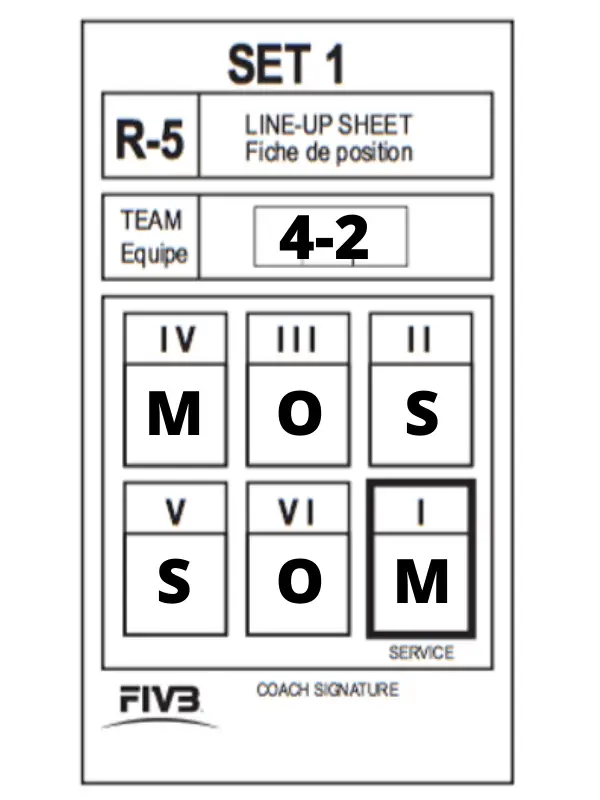
4-2 Rotation Guide
Now before I dive into this, it is worth noting that other teams may play these positions slightly differently. For example some teams play the outside hitter at position 5 when they are in the back row.
However I like to have the outside hitter at position 6 so they can attack the ball still if the pass is off the net and the setter needs a back court players help.
It is much easier to set the ball in the middle of the court than trying to force the ball out towards the wing.
So with that being said just be aware positions may change ever so slightly, but this rotation guide should be a good step forward in teaching you rotations.
Now I understand rotations are confusing at the best of times so I didn’t want to cluster the diagrams with the full position names.
If you are unclear about what any of the letters represent you can use the below key to work it out.
S = Setter
O = Outside Hitter (AKA Wing Hitter)
M = Middle
Where the letters are positioned is where each player will stand when the ball is served. Once the ball has crossed the net everyone except the player about to pass the ball will begin the move as the arrows indicate.
Based on the players starting in the Line-up noted above, this would be rotation 1 when receiving the serve
Rotation 1
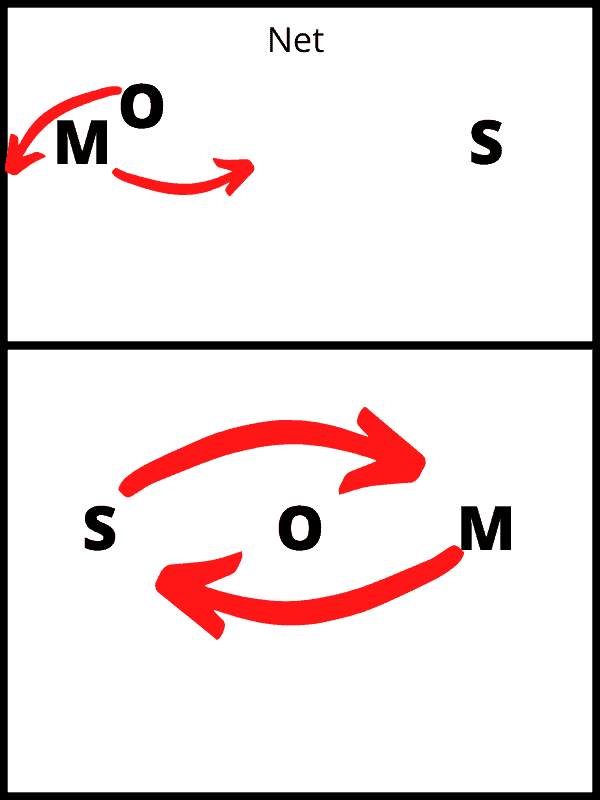
Now once everyone has rotated one position in a clockwise direction, when next receiving you will be in the next rotation
Rotation 2

One of the really nice things with the 4-2 roation, is not only are the rotations nice and simple to follow but there is only 3 rotations to worry about.
Rotation 3

The 5-1 Volleyball Formation
The 5-1 Volleyball Formation is the most commonly used formation in most high level volleyball. It relies on a dedicated setter with the 5 other players acting as hitters.
Unlike the 4-2 rotation there isn’t 2 setters which means this is the first rotation in which we see the introduction of a new position called ‘The Opposite’
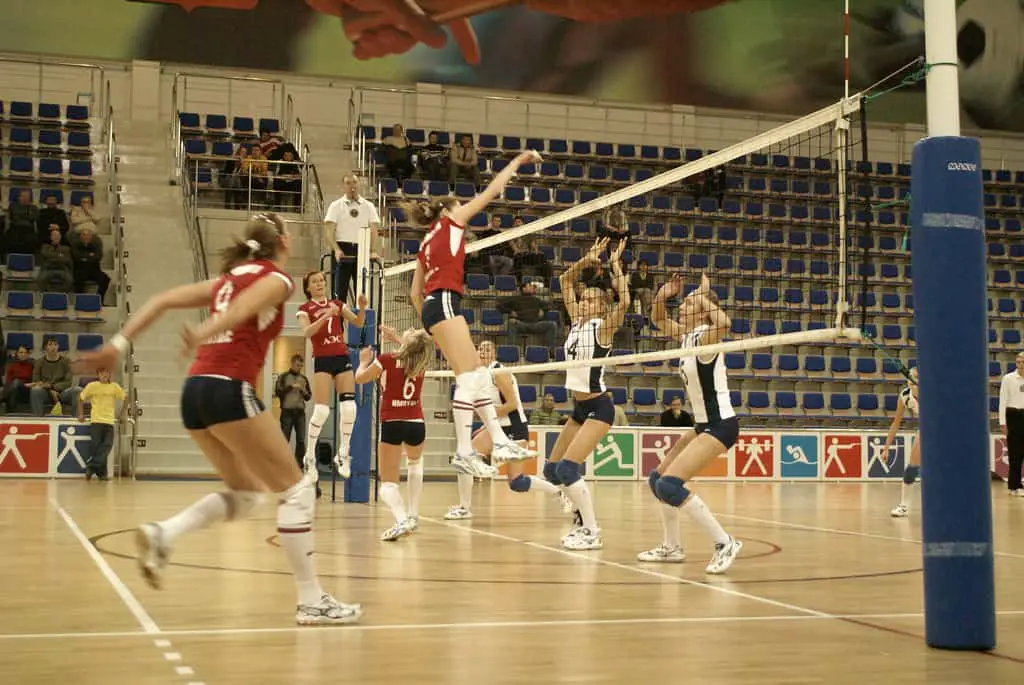
Advantages of the 5-1 Formation
Hitting Options
A good benefit to running a 5-1 formation is the plethora of hitting options that become available. Not only do you get the addition of the opposite hitter but it also allows other outlets such as the 10 hit, this is the back court attack from the 1 position (Bottom Right), the pipe which is the attack from position 6 (Bottom Middle) and in extreme situations even the 50 which is the back row attack from position 5 (bottom left Position).
Consistency
One of the other main benefits to using the 5-1 formation is it means the setter is the same person every time.
This allows the setter to not only become more consistent but it also allows for the remaining players to build a good relationship with the setter.
Knowing exactly how fast the set will be and at what height makes for a much more effective and efficient attacking line.
Disadvantages of the 5-1 Formation
Easy to Get Out of System
One of the main drawbacks to this formation is that teams can be easily put out of system.
What this means is the team has to adjust their play on the fly meaning hitting options become difficult or unavailable.
An example of this would be if the setter takes the first ball another player would have to come and take the set. Normally this would be the libero from a back row position.
When this happens it becomes very difficult for the team to run a quick middle which makes the play much more broadcasted and obvious. This allows the opposition to better set up their block and be ready for the attack.
Can Leave Weakness in Defense
Another drawback of this formation is when the setter is back row it can leave a weakness in the defense. Now it is true at high level the setter will be disciplined and focus on defense first however the setters main purpose is to set up teammates for the attack.
With this in mind the setter ideally wants to avoid taking the first ball and causing an out of system play, because of this the setter may have a tendency to creep forward and expect the 6 player to assist a lot more on defense.
This can lead to some sloppy points being conceded as the setter doesn’t take the first ball and the 6 player doesn’t expect to cover the setter so heavily.
Confusing Rotations for Beginners
The last drawback to the 5-1 formation is the rotations can be confusing to new players or beginners. The 5-1 Formation is the only formation with 6 different rotations, this can be overwhelming especially for new or inexperienced players.
Why It’s The Most Popular Formation
After reading the above and seeing that I actually listed more drawbacks than advantages, you may be wondering why it’s the most popular formation and rotation set.
Well the simple answer is my points under the advantages. Not only does it make the set more consistent but it also offers the most flexibility and creativity when it comes to hitting options.
5-1 Formation Starting Line-up
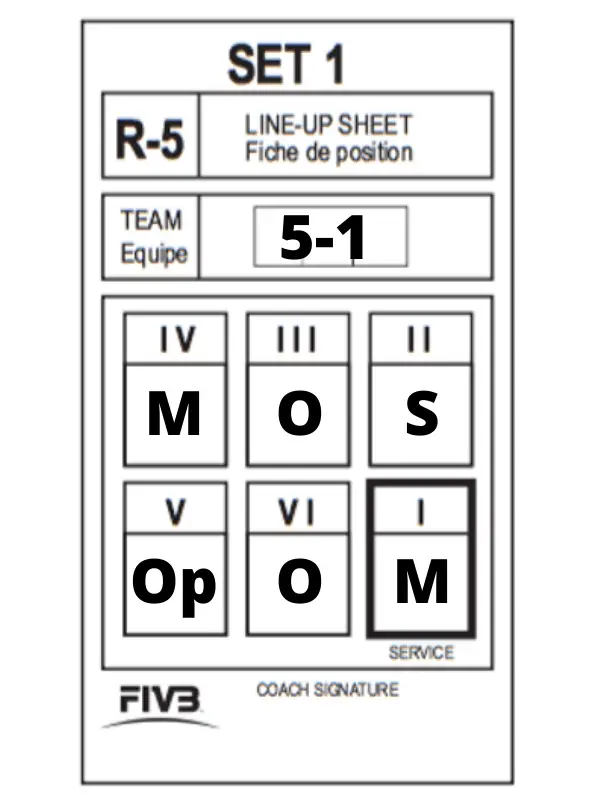
5-1 Rotation Guide
As mentioned above other teams may play these positions slightly differently.
So with that being said just be aware positions may change ever so slightly, but this rotation guide should be a good step forward in teaching you rotations for the complicated but extremely common 5-1 formation.
If you are unclear about what any of the letters represent you can use the below key to work it out.
S = Setter
O = Outside Hitter (AKA Wing Hitter)
M = Middle
Op = Opposite Hitter (AKA Right Side Hitter)
Where the letters are positioned is where each player will stand when the ball is served. Once the ball has crossed the net everyone except the player about to pass the ball will begin the move as the arrows indicate.
Based on the players starting in the Line-up noted above, this would be rotation 1 when receiving the serve
Rotation 1
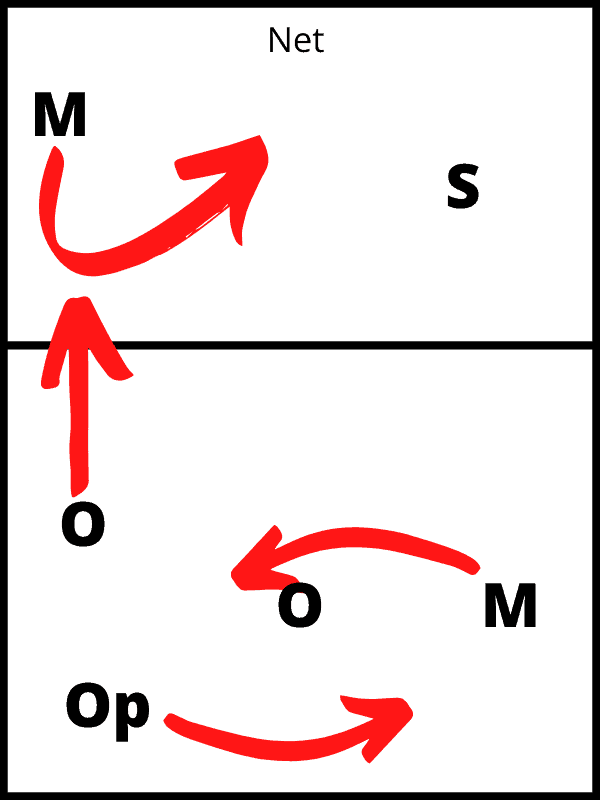
Once the first rotation is completed and you lose your 1st point after rotating you will go into the 2nd rotation.
Rotation 2

Moving onto the next rotation
Rotation 3
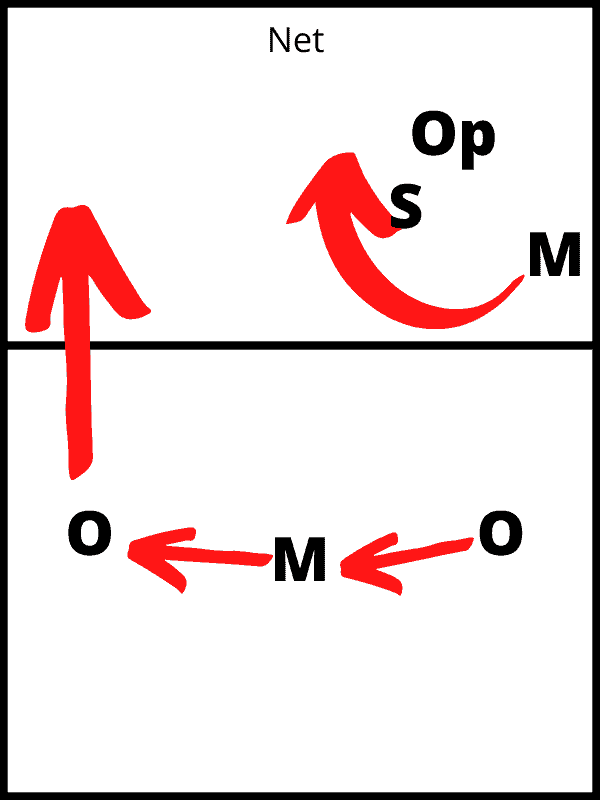
Onto rotation 4
Rotation 4
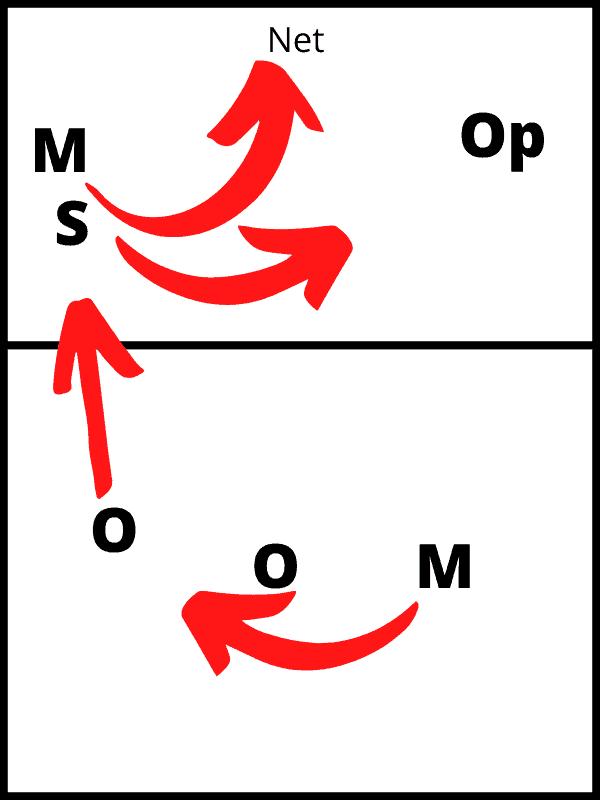
Rotation 5 is the first rotation where the setter returns to the front row
Rotation 5

After rotation 5 is completed we go into the final rotation
Rotation 6

The 6-2 Volleyball Formation
The 6-2 Volleyball formation can be a very effective tactic however it is also probably the most risky and confusing.
Now as I said earlier the 6-2 formation doesn’t mean that there are 8 players on court, but it does mean that there are 6 hitters and 2 setters.
The way in which this works is the setter who is in the back row will always step forward (Where possible) and set the ball.
This allows the front court setter to act as a front row hitter.
By doing this it means that you have 5 setting options at all times and 3 of them will always be front row.
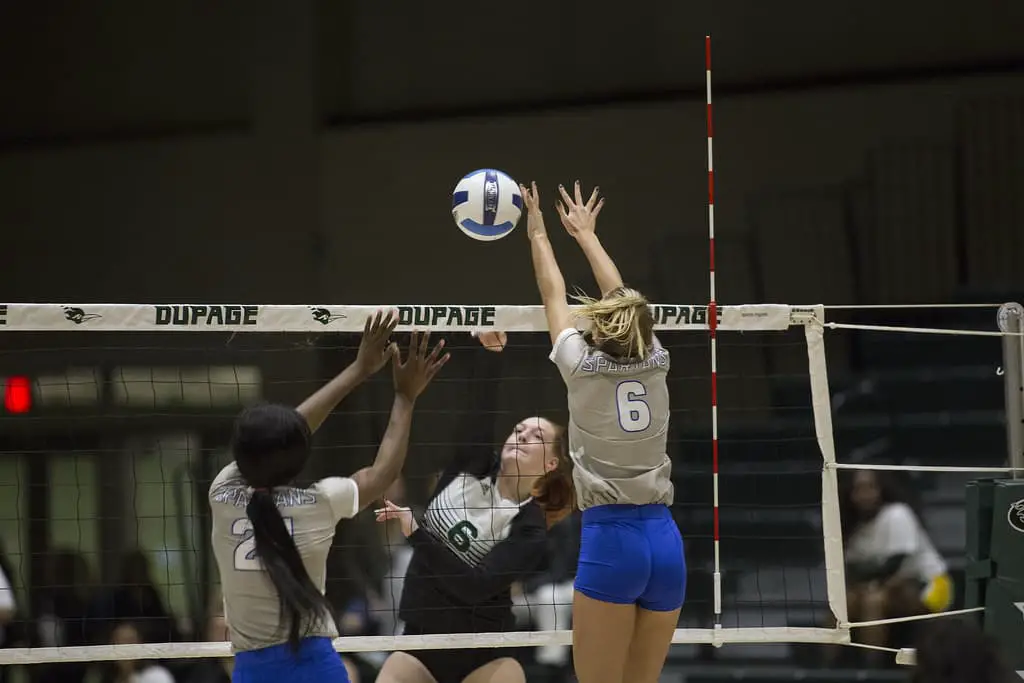
Advantages Of The 6-2 Formation
3 Front Row Hitters
This formation can lead to a lot of confusion for the blocking side unlike the other rotations when a setter is front court, apart from the occasional trickery from the setter where he jumps and dumps the ball over rather than setting, for the most part the blockers can be very confident that the setter isn’t going to spike the ball.
This means the player that is matching up against the setter can often help the middle blocker much easier or even swing all the way over to create a 3 man block.
With that being said they would still have to concern themselves with the opposite from the other team who would likely be ready and waiting behind the setter.
However in this formation you not only still have the 10 option, but with all 3 front court players being able to spike the blockers can never fully discount any attacking player.
A 2nd Setter For Out of System Plays
Another massive benefit to having a 2 setter system is that if your back row setter takes the first ball in reception the opposite setter can step up and set the ball.
Having a skilled setter as a backup means even in a play that would normally put a team out of system can be salvaged.
Line-up Flexibility
The last benefit that comes to mind with the 6-2 formation is the ability to chop and change the line-up.
For example you may want to sub one of the setters out when they get front court to bring on a skilled hitter or big blocker.
Being able to do this may just tip the scales in your favour in these tight games.
Now admittedly you are governed by substitution limits and restrictions but even with these sub limits in place it can still add a few points in your favour.
Drawbacks Of The 6-2 Formation
Confusion between Setters
Now I am not sure if this is a universal drawback or just something that I always struggle with, however this formation always stumps me.
As a setter it is a force of habit to always set up and take the 2nd ball, trying to force yourself out of this habit is extremely difficult.
Yes it’s true I’m sure if I played the rotation enough I would get to grips with it, but it isn’t the first time I have seen other teams stumped by this same thing and I’m sure it won’t be the last time.
Weakness in Defense
Now the reason I say this formation can be risky is because it can lead to some confusion or even leave holes in the defense.
For example if the back row setter is creeping forward ready to set, this could easily leave a hole for the opposition to exploit at the 1 position.
Now having a disciplined player who prioritizes defense over setting would easily solve this problem, however this leaves a different issue as now the team is out of system and the second setter or another player must take the set.
Alternatively if the opposition have to give a free ball the 2 player could swap with the setter as the free ball comes over the net to take the first ball and free up the setter.
6-2 Formation Starting Line-up
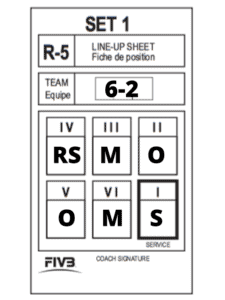
6-2 Rotation Guide
I feel like a broken record, but remember other teams may play these positions slightly differently.
So with that being said just be aware positions may change ever so slightly, but this rotation guide should help you understand the basics of the 6-2 formation.
If you are unclear about what any of the letters represent you can use the below key to work it out.
S = Setter
O = Outside Hitter (AKA Wing Hitter)
M = Middle
RS = Right Sided Hitter (AKA Second Setter)
Where the letters are positioned is where each player will stand when the ball is served. Once the ball has crossed the net everyone except the player about to pass the ball will begin the move as the arrows indicate.
Based on the players starting in the Line-up noted above, this would be rotation 1 when receiving the serve
Rotation 1

Moving round to rotation 2
Rotation 2
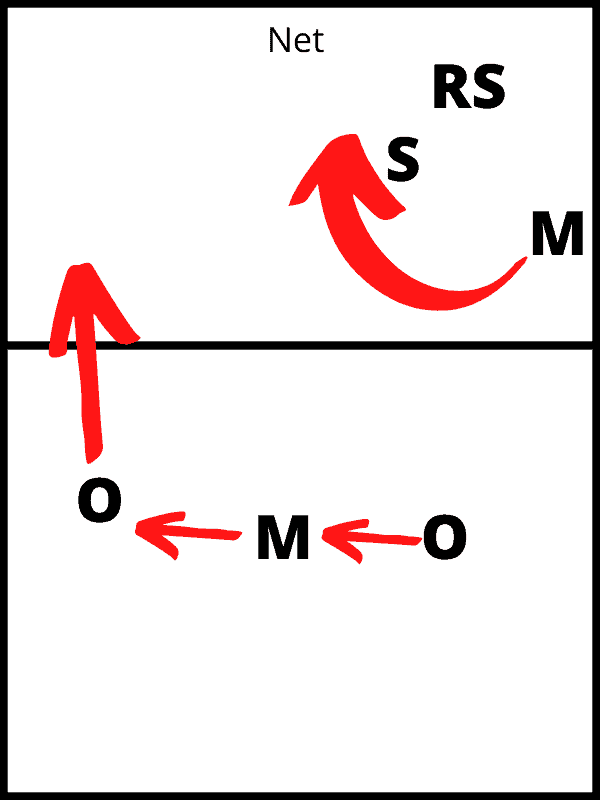
Again much like the 4-2 formation, this also only has 3 rotations. (allbeit a confusing 3, if you are a setter like me)
Rotation 3

Hopefully having read through the above you feel a lot more confident in exactly what each formation offers and where exactly you should be rotating regardless of which formation you use.
Now I get rotations are a very daunting thing especially when you are just staring at my scribbles above.
I want you to really nail these rotations so I am going to put a links to download these rotation cards below.
Simply click on the formation your team uses to print out a page with all the rotations on so you can take this to your next session and look like a rotation pro.
